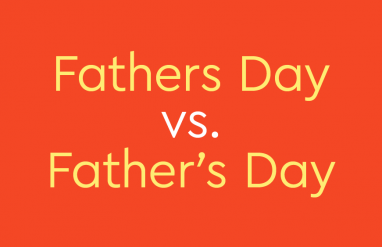There are some things that we do often: We eat. We sleep. We smile. We learn. We laugh. We think. We jazzercise. Well, maybe not so much that last one anymore. But something that we definitely do often is use verbs in sentences. Verbs are words that we use to refer to actions or states of being. However, we don’t always use verbs to say that we performed an action on something or that affected someone. There are several different types of verbs, and sometimes we use a particular type of verb called an intransitive verb to describe actions that aren’t received by anything or anyone in the sentence. But what exactly do we mean by this? Read on.
What is an intransitive verb?
An intransitive verb is a “verb that indicates a complete action without being accompanied by a direct object, as sit or lie, and, in English, that does not form a passive.” Our definition does a good job of saying what an intransitive verb is, but let’s break the two major points a little more.
1. Intransitive verbs are not accompanied by a direct object. In grammar, a direct object is “a word or group of words representing the person or thing upon which the action of a verb is performed or toward which it is directed.” For example, in the sentence She builds houses, the direct object is houses because it is having an action performed on it by the subject she. What does she build? She builds houses. When a verb is used with a direct object, we refer to it as a transitive verb.
However, we can also use verbs without direct objects. For example, the sentence Fish swim does not have a direct object; the fish aren’t “swimming” something. Because there is no direct object in the sentence, the verb swim is an intransitive verb.
Just because intransitive verbs don’t use direct objects, it doesn’t mean they are only used in shorter sentences. Often, we use modifiers such as prepositional phrases, adverbs, and dependent clauses with intransitive verbs to provide more details or information. You can see examples of this is the following sentences that use intransitive verbs:
- The deer ran around the lake, through the trees, and over the fallen logs.
- The carpenters work quietly and quickly.
- I listen to music because it relaxes me.
2. In English, intransitive verbs are not used in the passive voice. When we use the passive voice, we say that the subject is having an action performed to it rather than performing an action. Here is an example of a sentence in the passive voice:
- The cake was baked by me.
Only transitive verbs can be used in the passive voice in English. If you try to use an intransitive verb in the passive voice, you will find it difficult to create a sentence that makes any sense. The following nonsensical sentences show what happens when we try to use intransitive verbs in the passive voice:
- The stinky cheese was smelled like an old shoe.
- My dog was slept all day.
- Sadly, unicorns were never existed.
These two major points will help you identify intransitive verbs. However, there is one important thing to keep in mind: some verbs can be used as both transitive or intransitive verbs depending on meaning and context. The following two sentences show the verb fly used as a transitive and intransitive verb:
- Intransitive verb: Birds fly.
- Transitive verb: Pilots fly airplanes.
In the first sentence, the verb fly is not used with a direct object; the birds aren’t “flying” anything. In the second sentence, the verb fly is used with a direct object; the pilots are indeed “flying” something: planes. When trying to decide if a sentence or clause has a direct object, think about how the verb is being used and what the subject is doing. If a verb is referring to a subject that is not doing something to an object or to a person then it is most likely an intransitive verb.
📝 Important note: we’ve noted that intransitive verbs do not form a passive, and we’ve also noted that many verbs can be both transitive and intransitive depending on their use. When a verb can be both transitive and intransitive, its transitive senses can still be used in a passive voice, but its intransitive senses cannot.
For instance, from the above example using fly, we can say Airplanes are flown (by pilots). But there is no passive equivalent of Birds fly. The sentence Birds are flown would imply that someone or something is flying them in the transitive sense of that verb, e.g., The birds are flown on a special airplane to relocate them to the wildlife refuge. By making this sentence active, we can see we are using the transitive sense of fly: A special airplane flies the birds to relocate them to wildlife refuge. (It’s a weird example, we know. Ahhh, grammar! 😭🤬)
List of intransitive verbs
Many verbs can be used as either a transitive or intransitive verb. The key point to remember is that if a verb can be used without a direct object, it can be an intransitive verb. The following list gives examples of verbs that can be used as intransitive verbs:
- arrive, bow, crawl, disagree, emerge, faint, gasp, howl, immigrate, jump, kneel, laugh, march, nap, ooze, pause, quake, rest, smile, tingle, understand, vibrate, wait, yell, zoom
Intransitive verb examples
Let’s look at different examples of intransitive verbs used in sentences. Again, an intransitive verb is not used with a direct object and cannot be used in the passive voice. You will notice that none of the following intransitive verbs are used with a direct object and are not written in the passive voice.
- The dogs barked.
- She lives in a quiet neighborhood.
- We go to California every summer in order to visit my grandparents.
- Your idea sounds really good.
- I panicked when I realized I’d lost my wallet.
Do you feel comfortable with irregular verbs? Learn more about them here.
Intransitive verb rules & best practices
Let’s review the two main points of intransitive verbs:
- Intransitive verbs are NOT used with direct objects.
- Intransitive verbs cannot be used in the passive voice.
If you remember these two important points, it will be easy to use intransitive verbs correctly. If you are unsure if a verb can be used as an intransitive verb, our incredible dictionary can help you out: if the phrase “used without object” appears alongside a verb, it means that the verb can be used as an intransitive verb.
Many different kinds of verbs can also be intransitive verbs. Both regular and irregular verbs can be intransitive verbs. Action verbs, stative verbs, and linking verbs can all be intransitive verbs—what verb they are all depends on how they are being used. Linking verbs do not use direct objects and instead provide more information about the subject. For example, this sentence uses an intransitive linking verb: The child is all grown up.
Additionally, intransitive verbs can be used in all 12 of the verb tenses.
Let’s put everything you have learned about intransitive verbs to the test. Look at each of the following sentences and see if you can figure out if each verb is or is not an intransitive verb.
- Wolves hunt.
- Wolves hunt sheep.
- The birds chirped outside my window.
- The happy children ate the candy.
- I walked for an hour.
- She opened all of the boxes.
- The mall opened at 7 a.m.
- My favorite band will perform at the concert.
- Armando the Amazing will perform incredible magic tricks at the show.
- Every house in town was built by local construction companies.
Answers: 1. Intransitive 2. Transitive 3. Intransitive 4. Transitive 5. Intransitive 6. Transitive 7. Intransitive 8. Intransitive 9. Transitive 10. Transitive













